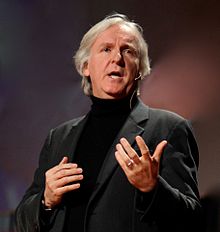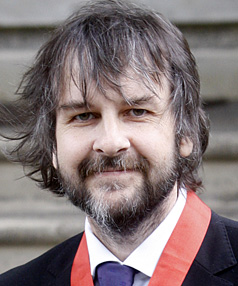Film Upgrade: 60 impressions per second
What if you shoot faster?
 Last year, at a CinemaCon event in Las Vegas, director James Cameron gave a great presentation on the benefits of shooting films with an increased frame rate (HFR, 48 or 60 frames per second against the traditional 24). Director Peter Jackson supported the initiative and decided to apply the technology of shooting at 48 frames per second in his film The Hobbit: An Unexpected Journey, which will be released on cinema screens in December. During this year's CinemaCon, viewers were able to see 10 minutes of the picture in stereoscopic format and at double the frequency, which would thus be the first one completely captured in the HFR.
Last year, at a CinemaCon event in Las Vegas, director James Cameron gave a great presentation on the benefits of shooting films with an increased frame rate (HFR, 48 or 60 frames per second against the traditional 24). Director Peter Jackson supported the initiative and decided to apply the technology of shooting at 48 frames per second in his film The Hobbit: An Unexpected Journey, which will be released on cinema screens in December. During this year's CinemaCon, viewers were able to see 10 minutes of the picture in stereoscopic format and at double the frequency, which would thus be the first one completely captured in the HFR. The last 80 years, the standard in the film industry is shooting at 24 frames per second. In Peter Jackson's video message from New Zealand, where the film is being shot, the director urged the cinema owners to show the film at 48 frames per second. According to him, a higher frame projection speed creates “the illusion of real life, where movements are felt smoother and the viewer does not deal with the effect of strobe”. Cameron is also not going to fall behind: it is already known that Avatar 2 and Avatar 3 will be released in a new format.
The last 80 years, the standard in the film industry is shooting at 24 frames per second. In Peter Jackson's video message from New Zealand, where the film is being shot, the director urged the cinema owners to show the film at 48 frames per second. According to him, a higher frame projection speed creates “the illusion of real life, where movements are felt smoother and the viewer does not deal with the effect of strobe”. Cameron is also not going to fall behind: it is already known that Avatar 2 and Avatar 3 will be released in a new format.')
What is the essence of this technology and what impressions did the first viewers have?
Smooth motion in movies and on video
The required frame rate to create a feeling of smooth movement is ~ 16-18 frames per second.
 However, with a higher frequency, for example, starting at ~ 50 frames / sec, the image becomes noticeably smoother and more believable. This is noticeable when comparing on the TV screen a videotape taken with greater time resolution and a movie. When watching a video (or transmission from a television camera), the viewer sees 50 (or 60) images per second, each of which displays a separate phase of movement, due to the interlaced scanning of the transmitting camera. A completely different picture is observed when watching a movie, shot at a frequency of 24 frames per second (with telekino projection, the frequency increases to 25 fps, which is imperceptible to the eye). The TV, which also has interlaced scanning, still shows only 25 images per second due to the fact that each frame of the movie is transmitted twice: first, with an even field, then an odd one. At the same time, unlike the video, in which each field transmits a separate phase of movement, the temporal discreteness of the film is twice as low. Therefore, the motion in the movies looks more generalized than in the video. In some professional video cameras, there is a special “cinematic” mode that reduces the temporal discreteness of an image by simultaneously storing even and odd image fields with the matrix while maintaining resolution based on the total number of lines in a frame. As a result, both fields display the same phase of movement, bringing the effect of image perception to cinematic.
However, with a higher frequency, for example, starting at ~ 50 frames / sec, the image becomes noticeably smoother and more believable. This is noticeable when comparing on the TV screen a videotape taken with greater time resolution and a movie. When watching a video (or transmission from a television camera), the viewer sees 50 (or 60) images per second, each of which displays a separate phase of movement, due to the interlaced scanning of the transmitting camera. A completely different picture is observed when watching a movie, shot at a frequency of 24 frames per second (with telekino projection, the frequency increases to 25 fps, which is imperceptible to the eye). The TV, which also has interlaced scanning, still shows only 25 images per second due to the fact that each frame of the movie is transmitted twice: first, with an even field, then an odd one. At the same time, unlike the video, in which each field transmits a separate phase of movement, the temporal discreteness of the film is twice as low. Therefore, the motion in the movies looks more generalized than in the video. In some professional video cameras, there is a special “cinematic” mode that reduces the temporal discreteness of an image by simultaneously storing even and odd image fields with the matrix while maintaining resolution based on the total number of lines in a frame. As a result, both fields display the same phase of movement, bringing the effect of image perception to cinematic.Cinema
In silent cinematography, the standard frequency of filming and film projection was 16 frames per second. With the advent of sound in the movie, the frequency of 24 frames per second became the standard, because the old speed of continuous motion of the film was not sufficient to obtain the necessary frequency range of high-quality optical soundtrack. To slow down or accelerate the movement on the screen there is accelerated and slow motion (time-lapse) shooting. Filming at a frame rate other than the standard one allows you to observe processes on the screen that are invisible to the eye or add an additional artistic effect to the movie.
Unlike television, which does not have a global frame rate standard, in sound cinema the frame rate is standardized and 24 frames per second is the standard frame rate for shooting and projection worldwide. In some countries, this forces the use of frequency interpolation during tele-movie projection. However, attempts by some developers to change the generally accepted frequency of 24 frames by 30, close to the American standard of decomposition in television, were unsuccessful, and the cinema format Todd AO , originally designed for such a frequency of shooting and projection, was brought to a common standard. Some formats calculated for the frequency of 48 and 60 frames per second were not successful. The only exception is some standards for 3D-projection, which use double the frequency of 48 frames per second for the projection of the stereo pair. At the same time, for each eye, the frequency remains familiar - 24 frames per second. In digital cinema, the frame rate is also assumed to be 24 worldwide. The fractional frequency of 23.976 frames per second is non-standard and is used during telekinetic projection to interpolate into the American standard of color television NTSC . All filming frequencies other than 24 frames per second are non-standard and are used in special cases. At the same time, attempts to increase the frequency of filming and projection to enhance the effect of the presence, which began almost immediately after the appearance of cinema, continues to this day.
Prospects are not so bright.
Representatives of various publications that were present at the Hobbit episode, speak of him rather bewildered - although they admit that it was easier to perceive 3D than ever. For example, a Collider correspondent writes:
48 frames per second is a very unusual sight, and I'm not sure that it will appeal to ordinary cinema visitors. It looks like a reality on a movie screen - there is no more blurring of the image, no dark corners, but is it good? The Hobbit is not like a movie, but like high definition television.
Resource TheWrap published an even tougher review:
It was more like a Mexican TV series than Avatar. There is no doubt that HFR will have its fans, but in my opinion, the excessive clarity of the image only spoiled everything that was created by the rich imagination of Jackson. ”
The main complaint about the "Hobbit" is that the HFR makes the image "non-kinematic". But perhaps when the first shock passes, will the attitude towards experimental technology change? Peter Jackson foresaw a similar reaction, and shortly before the festival he wrote on Facebook:
Adherents of traditional cinema will not like too clear and smooth image. Many of our team were the same, but now they have become HFR followers. You get used to the new image quality very quickly. This is similar to the moment when the vinyl was replaced by digital discs. I have no doubt that in the future all films will be shot and shown with a high frame rate. ”
We look with our own eyes
A small video illustration of the difference of 24 and 48 frames per second. 7 mb.
Movie trailer Inseption 48fps, 211 mb.
Excerpt Avatar 48fps , 42 mb and 60fps , 120 mb.
PS For pedants and primers, the topic was prepared on the basis of materials from the sites wikipedia, 3dnews and filmpro.ru, but did you read it there? =)
Source: https://habr.com/ru/post/142931/
All Articles